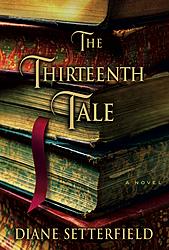 The Thirteenth Tale
The Thirteenth Tale by Diane Setterfield was probably one of the most publicised books last year. It has become something of a blockbuster in the US. And,
review after
review, we have been reporting its Jane Eyre or Brontë references time and time again. Therefore, when BrontëBlog had the chance to read it, we decided we would publish our own review.
Diane Setterfield's book has been described as a Gothic mystery tale. Mysterious it certainly is, and occasionally Gothic. But basically it is a tale, even sometimes a fairy tale
(1). The book starts with a bibliophile kind of statement where the main character, Margaret Lea, is introduced. She is a rather dull, plain bookseller's daughter that has chosen to live as a voyeur of life through books. She lives through the lives of others.
Vida Winter, the improbable crossing between Barbara Cartland and a
Dickens-of-our-times as she is described in the novel, lives (or rather survives) through her stories. She needs to explain them. But this time she needs to tell her story, her real one. And Margaret is there to listen.
(2)Explaining stories. The author loves to explain stories inside stories that unfold themselves in other stories, just for the pleasure of narration. Not always all the stories end together. There are holes in narrative and not everything fits together. But sometimes imperfections are not drawbacks, sometimes unexpectedly they open other interpretations and the story, the tale inside the tale, just continues to unfold...
The novel itself is a rather post-modern Gothic pastiche. At times it would seem that the author has taken several very well-known and some not so well-known references, has put them together and has mixed them vigorously. Rebecca, The Woman in White... but especially Henry James's The Turn of the Screw are explicitly referred to in the novel. And this reviewer thinks that Kate Atkinson's first novel
Behind the Scenes at the Museum and
Tom Tryon's The Other, an obscure novel better known by
its cinematographic adaptation by Robert Mulligan, are a paramount influence... or an extraordinary case of parallel thinking.
Brontë influences? Yes, there are plenty. But, in the opinion of this reviewer, they are not really relevant to the story itself. It's not that the story, as has been described, is Brontë-esque, the Brontë references are there to help with the narration, to suggest a connection to some kind of literature, to try to give a sense of atmosphere. Some elements of Jane Eyre can be traced in Margaret Lea's personality but they are not truly relevant. More evident are the perverted echoes of Wuthering Heights that can be found in the relationship between Isabelle and Charlie. And, of course, the presence of Jane Eyre, the book, is prominent in the development of the story. Almost like a supporting character that in the end has less importance than we had been led to believe.
(3)The Thirteenth Tale's endings, in plural, try to answer all the questions that have appeared along the way. We don't know if the fact that they fail in explaining everything is deliberate or not, we want to think this is not a failure at all, but an intended device. The problem, for us, is precisely that they try to explain too many things. Sometimes things work better in the readers' imaginations than when they are visualized, made too specific. Take The Thirteenth Tale, the story inside the story, as an example.
The Thirteenth Tale has caused us mixed feelings. It was a nice, and sometimes very exciting, read. But more times than we would like we had the feeling of reading a mixed combination of previous novels without the solid architecture of the aforementioned works. But probably, this is a Margaret Lea kind of criticism. The millions of readers of Vida Winter's novels would have liked The Thirteenth Tale better.
(1)It's not Aurelius a character that seems to have been created by a Grimm brother?
(2)It is never specified when the novel is set in a deliberate attempt to suspend the real world outside the novel. Nevertheless there are clues around the novel that more or less point to dates about the late seventies or the eighties .
(3)Although a governess and a fire also appear.
Categories: Books, Review









Hey, Bronte-bloggers. I could not agree more. Thanks for linking to my live-blog of Jane Eyre, and do check out my very in sync with you review of The Thirteenth Tale here at Venus Zine:
ReplyDeletehttp://venuszine.com/stories/arts_reads/3458
Yes, we have read your review and certainly we agree on this book. The fact that so many reviews (in prestigious media) repeat once and once again the Brontë influence on the book was the reason behind our review. We usually only review Brontë-related books.
ReplyDeleteHi,
ReplyDeleteI want to suggest you this new Great Site:
http://charlottebronte.altervista.org
Bye